Garvan Institute of Medical Research
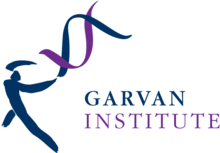 | |
| Motto | Breakthrough medical research |
|---|---|
| Founder(s) | Sisters of Charity |
| Established | 1963 |
| Mission | Medical research |
| Director | Professor John Mattick AO, FAA |
| Faculty | University of New South Wales |
| Adjunct faculty | St Vincent's Hospital, Sydney |
| Staff | approx. 650 |
| Location | Victoria Street, Darlinghurst, Sydney, New South Wales, Australia |
| Website |
www |
The Garvan Institute of Medical Research is an Australian biomedical research institute located in Darlinghurst, Sydney, New South Wales. Founded in 1963 by the Sisters of Charity as a research department of St Vincent's Hospital, it is now one of Australia's largest medical research institutions with approximately 650 scientists, students and support staff. The director of the Institute since 2012 is Professor John Mattick AO, FAA.
Garvan's research is focused on the major diseases that affect today's society: cancer, diabetes, osteoporosis, Alzheimer's disease, Parkinson's disease; as well as eating disorders, and autoimmune and inflammatory conditions such as rheumatoid arthritis and asthma. It specialises in genetic and molecular technologies, and emphasises collaborative research.
In 2014 the Institute became one of only three organisations in the world – and the only one outside the United States[1] – able to sequence the human genome at a base cost below US$1,000 each (the $1,000 genome) when it purchased the next generation of genome sequencing equipment, which is capable of sequencing 350 genomes a week (18,000 a year).[2][3]
Purpose
The Garvan Institute states its mission as being “…to make significant contributions to medical research that will change the directions of science and medicine and have major impacts on human health. Garvan strives to enhance and develop research programs that combine fundamental science with strong clinical interactions.”[4]
Garvan's ultimate goal is the prevention, treatment or cure of some of the most widespread diseases currently affecting society.
History
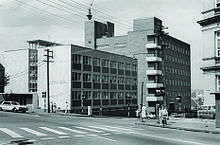
Establishment and early years
Funds for its establishment were provided by a centenary hospital appeal by the Sisters of Charity for St Vincent's Hospital. Helen Mills, the largest donor, asked for the centre to be named after her father, the late James Patrick Garvan (1843-1896), a distinguished New South Wales parliamentarian and business leader.[5]
Construction of the original Garvan Institute building began in January 1962 on the corner of Victoria, Burton and Chaplin Streets. It consisted of a basement and three floors and allowed for the eventual development of a six floor building. The Institute was officially opened on 17 February 1963 by Bernard Marmaduke Fitzalan-Howard KG, GCVO GBE, the 16th Duke of Norfolk, with the opening ceremony attended by 1500 supporters and dignitaries.
Over the following two years, research projects were initiated, lab workers appointed, and a Management Committee established. Research during the early years was dominated by endocrinology, fostered by the presence of the State Reference Laboratory for endocrine assays. A hormone radioimmunoassay service at Garvan in 1964-1965, which was a significant component of the research activity and provided a steady source of funds, an important consideration before regular research grants were available. The late 1960s and 1970s saw the expansion of scientific staff at the Institute, including the arrival of a critical mass of key senior researchers, many of whom are now recognised as ground breakers in their field.
The 1980s: increased funding
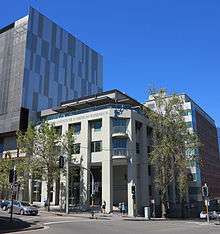
The Garvan Research Foundation was established on 1 January 1981, with the aim: “To support, assist and promote scientific and medical research within the Garvan Institute of Medical Research”.
In 1982 the National Health and Medical Research Council (NHMRC) awarded Garvan its first Program Grant for research into diabetes, while in May 1983 the Council of the University of New South Wales approved the affiliation of the Institute with the University, which continues to this day.
The New South Wales Parliament passed the Garvan Institute of Medical Research Act in 1984,[6] incorporating Garvan as an autonomous, non-profit research institute. In 1986, Garvan became one of only five 'centres of research excellence' in Australia to receive NHMRC 'block funding'. That, along with subsequent infrastructure funding from the NSW Government, allowed Garvan to expand into a world-class facility.
In 1989 the Institute launched its Dubbo Osteoporosis Epidemiology Study in Dubbo in regional New South Wales. The study has continued running to this day and is the longest running study of its kind anywhere in the world.[7]
The 1990s: expansion and construction
NHMRC funding and increased public financial support through the Garvan Research Foundation allowed the Institute to increase dramatically in size throughout the 1990s.
In 1992 the Institute was awarded one of the Federal Government’s prestigious Co-operative Research Centres, to focus on the development of internationally competitive products in the biopharmaceutical field. The Centre was a joint venture between Garvan, University of New South Wales, St Vincent’s Hospital, the Biomolecular Research Institute in Melbourne, the Commonwealth Serum Laboratories, Peptide Technology Ltd and Johnson and Johnson Research Pty Ltd.
The Institute was granted a large infrastructure grant by the NSW Government in 1994, and used this funding to build the world-class research facility it is currently housed in on the site of the original Garvan building. The new building was completed in 1997, when it was opened on 7 April by Prime Minister John Howard and Bob Carr, then Premier of New South Wales.
The 21st century: the rise of 'big science'
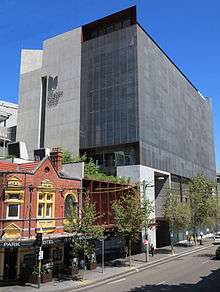
After advances in molecular biology in the 1990s came the 'big science’ of the 21st century. The launch in 2000 of the first draft of the human genome led to huge sequence databases and gene arrays, removing the need for painstaking testing of individual gene activity. Garvan embraced this new research model quickly and, in a similar way, more recently embraced proteomics and epigenetics, as well as the bioinformatics expertise required to analyse and interpret huge datasets.
In 2003 the NHMRC awarded a prestigious and highly competitive Program Grant of A$5 million to Cancer Research Program over a period of five years, forming a critical base for its continued work. In 2004 the Australian Cancer Research Foundation (ACRF) provided a grant of A$1.1 million to establish a Cancer Molecular Genetics Unit in collaboration with St Vincent’s Hospital. The grant enabled the purchase of equipment to analyse genetic changes in different tumour biopsies.
Between 2005 and 2010, under the leadership of CEO Carole Renouf, Garvan Research Foundation grew annual fundraising from an average of A$3m to A$15m, primarily through major gifts from individuals.[8][9]
The Kinghorn Cancer Centre, a A$100 million joint venture between Garvan and St Vincent's Hospital, was opened on 28 August 2012 by Prime Minister Julia Gillard.[10] The centre is named after the Kinghorn Foundation, one of the centre's main benefactors.[11] The Kinghorn Centre for Clinical Genomics (KCCG) was also established in 2012, with a commitment of A$9 million in funding from the Kinghorn Foundation. KCCG is Australia's leading medical research institute in medical genomics and informatics that translates into genome-based personalised medicine. The functions of the KCCG include high quality 'next generation' genome sequencing and diagnostic services.[12] In 2014 it was announced that the Garvan Institute would be one of the world's first organisations to purchase the next generation of genome sequencing equipment – to be located in the KCCG – capable of sequencing 350 genomes a week (18,000 a year) at a base cost below US$1,000 each.[3][13][14]
Structure and organisation
The Institute is organised into six medical research divisions: Bone Biology, Cancer, Diabetes and Metabolism, Genomics and Epigenetics, Immunology and Neuroscience.[15]
Many staff from the Cancer division are based in the Kinghorn Cancer Centre, a A$100 million joint initiative between Garvan and St Vincent's Hospital located next door to the Garvan building. This purpose built cancer care centre houses around 250 scientists, clinicians and support staff from both organisations, and is home to the Kinghorn Centre for Clinical Genomics.[12]
Fundraising and marketing for the Institute is handled by the Garvan Research Foundation, whose current Chief Executive Officer is Andrew Giles. Governance of the Institute and the Foundation is overseen by two boards of directors, the Institute's board including members nominated by the Trustees of St Vincent's Hospital, the Sisters of Charity, the NSW Minister for Health and the Federal Minister for Health.[16]
Research activity
The Institute’s research scope focuses on “…understanding the role of genes and molecular and cellular processes in health and disease as the basis for developing future preventions, treatments and cures.”[4] Areas of research include:
- Cancer
- Diabetes, metabolism and obesity
- Neurological diseases such as Alzheimer's, Parkinson's, hearing loss, mental illnesses and eating disorders
- Osteoporosis and bone biology
- Immunological diseases such as asthma, rheumatoid arthritis, multiple sclerosis and Sjogren’s syndrome
Research outcomes and achievements
Some of Garvan’s major breakthroughs have included the following:[17]
- Discovering a molecule that can switch appetite on and off, explaining extreme weight loss in late stage cancer
- Developing a test that may predict the outcome of prostate cancer more effectively than the standard (PSA) test
- Uncovering the role of abdominal fat in determining risk of type 2 diabetes and influencing insulin resistance
- Developing and commercialising a treatment for anti-inflammatory diseases such as rheumatoid arthritis
- Identifying the high risk of osteoporotic re-fracture and early death in men compared to women
- Identifying a pathway that reveals how a stress hormone in the brain can suppress the immune system
- Discovering that adult olfactory stem cells can spawn hearing-like cells, with the potential to restore hearing
Scientific publications
In 2013 Garvan published 230 peer reviewed research papers, achieving an ‘average impact factor’ greater than 8.62 for the top 80% of its publications. This was up from 224 publications in 2012, 223 in 2011, 203 in 2010, and 176 in 2009.[18]
Directors
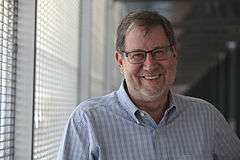
| Order | Incumbent | Start date | End date | Time in office | Notes |
|---|---|---|---|---|---|
| 1 |
| 1966 | 1969 | 2–3 years | |
| 2 | Leslie Lazarus | 1969 | 1990 | 20–21 years | |
| 3 | John Shine | 1990 | 2012 | 21–22 years | |
| 4 | John Mattick | 2012 | incumbent | 4 years, 129 days |
Other notable staff
- Professor Chris Goodnow BVSc, PhD, FAA FRS - Deputy Director and Laboratory Head
- Professor Vanessa Hayes - Laboratory Head, Human Comparative and Prostate Cancer Genomics
- Dr Russell Howard - Commercial Strategy Advisor, Kinghorn Centre for Clinical Genomics
- Professor David James FAA – formerly head of the Diabetes and Obesity division
- Associate Professor Amanda Salis – formerly leader of the Eating Disorders research group
Facilities
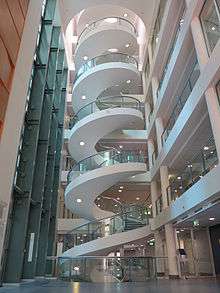
Garvan is based in a state-of-the-art research facility designed by renowned Australian architect Ken Woolley. Incorporating the old St Vincent's Hospital Nurses Home, the building features an iconic DNA-inspired helical staircase, and a dome-covered atrium that contains several large research laboratories. The foyer area galleria, library underneath the atrium and 300 seat auditorium in the lower ground floor are used for professional and social functions by Garvan and non-Garvan groups.
The Institute’s core research facilities incorporate a range of cutting-edge equipment and expertise, with some scientific facilities used by external researchers on a pay per use basis. Garvan’s research facilities and technology platforms include the following:[19]
- Animal Imaging
- Animal Research
- Biodata Visualisation
- Bioinformatics
- Clinical Research Facility
- Flow Cytometry
- Functional genomics
- Genomics
- Histopathology
- Mass Spectrometry
- Microscopy
- Molecular Genetics
Garvan’s emphasis on the clinical application of its medical research is seen particularly in The Kinghorn Cancer Centre, run in conjunction with St Vincent’s Hospital, which houses a mixture of research and clinical facilities, including:[20][21]
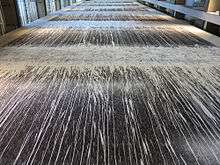
- Patient waiting areas
- Consultation suites
- Multi-disciplinary team suites
- A chemotherapy suite (the Nelune Centre)
- A hereditary cancer clinic
- A wellness centre, offering complementary therapies
- Clinical data management area
- Labs dealing with Tissue Culture, Molecular Pathology, Bioinformatics, Molecular Oncology, Functional genomics
- In house genomic sequencing conducted using the Illumina HiSeq X Ten platform
The centre’s clinical facilities have increased St Vincent’s capabilities for treating cancer patients: in 2013 the centre’s clinical facilities were used by 22,636 patients, an increase of 8.5% when compared with pre-Kinghorn Cancer Centre activity at the hospital. An even greater increase was seen in the percentage of patients receiving chemotherapy, with 12% more patients treated in the chemotherapy suite than at St Vincent’s prior to the opening of the centre. In addition, the St Vincent’s Hospital Hereditary Cancer Clinic in TKCC saw an 86% increase in new referrals.[22]
The lobby and atrium area of the centre features a permanent installation by British land artist Richard Long, White Water Falls (2012).[23]
Subsidiary and spin off companies
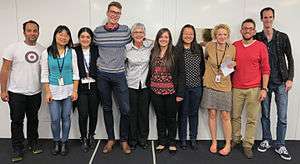
- Australian BioResources Pty Ltd (ABR) - Subsidiary that offers agistment and allied services to Garvan and other biomedical research institutes and universities on a non-profit, full cost recovery basis.[24]
- G2 Therapies Pty Ltd - Privately funded spin off biotechnology company developing and commercialising novel antibody based therapies in inflammation and cancer.[25]
Education
In partnership with University of New South Wales, Garvan provides a learning and teaching environment for PhD, MRes and Honours students aspiring to be part of the next generation of great medical researchers. Undergraduate students can undertake a casual, paid research placement at the Garvan as part of the Undergraduate Research Opportunity Program (UROP). As well as ensuring the development of scientific knowledge and skills for the future, students at Garvan are valued as important contributors to the life of the Institute as a whole. As of April 2014, the Garvan Institute had 107 PhD students and 13 Honours students.
Garvan students compete in the St Vincent's Hospital Precinct heat of the Three Minute Thesis competition held annually at the Garvan Institute in June. They then go on to compete in the UNSW Faculty of Medicine heat of the competition in July, and winners of that heat go on to compete in the UNSW Inter-faculty final of the competition.[26][27]
Funding and fundraising
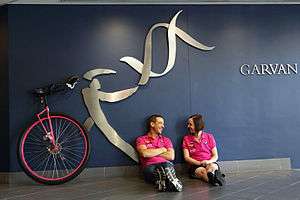
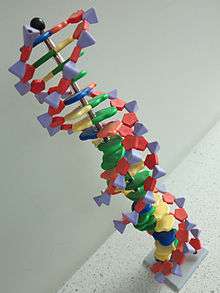
The Garvan Institute is funded from a diverse range of government and private sources including the corporate sector, trusts and foundations and individual donors. For every dollar the Institute receives from competitive Government grants, the Garvan Research Foundations has to raise an additional 70c to carry out the research.[28][29]
The Garvan Research Foundation was established in 1981 to provide fundraising support to the Institute’s medical research programs and promote its research. The Foundation has successfully grown from a fundraising base of 110,000 in its first year to around A$20 million a year.[30] In addition to its fundraising activities, the Foundation's activities have since expanded to support the Institute with a Public Engagement Program. This initiative aims to increase understanding of the need for and importance of Garvan's medical research across the broader community.
A number of high-profile public figures are involved with fundraising through the Foundation and promoting the work of the Institute:
- Singer/actress Delta Goodrem, a former cancer patient at St Vincent's Hospital, is Patron of the Kinghorn Cancer Centre;[31][32]
- Journalist/media personality Tracey Spicer is the face of the Garvan’s research into pancreatic cancer, the disease responsible for her mother's death;[33]
- Actor Samuel Johnson rode 15,478 kilometres (9,618 mi) around Australia on a unicycle to break a Guinness World Record with the aim of raising A$1 million for the Garvan Institute to find a cure for breast cancer.[34] His stated mission is to remind every Australian woman about the need to be 'breast aware', in an effort to promote early detection and improve survival rates, via his charitable foundation, Love Your Sister.[35] As of June 2014, he had raised nearly A$1.7 million[36] for Garvan and stated that he aims to boost that figure to A$10 million in future.[37] Johnson's sister was impacted by breast cancer.[38]
In the 2013 round of National Health and Medical Research Council grants, Garvan received A$15.5 million, out of a total funding pool of A$559.1 million. The Institute performed well, with a success rate of 26% for project grants, well ahead of the national average of 16.9%. Garvan received 11% of funding awarded to NSW as a whole, and 2.8% of the national total.[39]
World record attempts
Longest Senior Citizen Conga Line
On 2 May 2007, 477 senior citizens in Dubbo, New South Wales attempted to break the world record for the longest conga line made by senior citizens, in celebration of the 18th anniversary of the Garvan Institute's Dubbo Osteoporosis Epidemiology Study beginning. Unfortunately, as many participants did not have proof of ID to certify their age, the attempt was deemed to be unofficial.[40]
Largest DNA Model
On 21 October 2010 more than 150 Garvan staff and students worked with Sydney school students in a world record attempt to create the largest DNA model. They created a model that was the exact replica of the human Neuropeptide Y (NPY) gene measuring 25.66 metres (84.2 ft) in length, breaking the previous world record held by Konan University in Kobe, Japan.[41][42] To meet Guinness World Records guidelines Garvan had to follow the exact gene sequence for the NPY gene, which includes 1,300 base pairs (the basic elements of the genetic code used by all organisms to make proteins).
See also
References
- ↑ "Illumina Introduces the HiSeq X(TM) Ten Sequencing System". Press Release. Wall Street Journal. Retrieved 19 May 2014.
- ↑ Herper, Matthew. "The $1,000 Genome Arrives -- For Real, This Time". magazine. Forbes. Retrieved 19 February 2014.
- 1 2 "The future of genomic medicine has arrived in Australia". Media Release. Garvan Institute. Retrieved 21 January 2014.
- 1 2 "Garvan Institute of Medical Research - About Garvan". Corporate Website. Garvan Institute. Retrieved 10 February 2014.
- ↑ http://adb.anu.edu.au/biography/garvan-james-patrick-3598
- ↑ "Garvan Institute of Medical Research Act, 1984, No. 106" (PDF). Legislation. NSW Government. Retrieved 16 March 2014.
- ↑ "Bone Fracture Risk Calculator". Garvan Institute. Garvan Institute. Retrieved 9 January 2015.
- ↑ "CEO Carole Renouf". ABC. ABC. Retrieved 7 August 2014.
- ↑ "Woman of the Week: Carole Renouf". The Hoopla. The Hoopla. Retrieved 7 August 2014.
- ↑ "PM opens new Sydney cancer centre". News Website. 9MSN. Retrieved 22 January 2014.
- ↑ Turner, Brook. "No-regrets Kinghorn gives away $300m". News Website. Australian Financial Review. Retrieved 23 January 2014.
- 1 2 "The Kinghorn Foundation - Medical Research". Corporate Website. Kinghorn Foundation. Retrieved 22 January 2014.
- ↑ "Australians can map their genomes for $1,000 after institute buys world-first machine". News Website. ABC. Retrieved 25 February 2014.
- ↑ Medew, Julia (15 January 2014). "Australian researchers hail new cost-effective gene sequencing machine". Sydney Morning Herald. Retrieved 25 February 2014.
- ↑ "Garvan Institute of Medical Research - Breakthrough Research". Corporate Website. Garvan Institute. Retrieved 22 January 2014.
- ↑ "Garvan Institute of Medical Research - Governance". Corporate Website. Garvan Institute. Retrieved 22 January 2014.
- ↑ "Garvan Institute of Medical Research". Corporate website. The Kinghorn Cancer Centre. Retrieved 16 March 2014.
- ↑ "Garvan Institute 2013 Annual Report". Organisation Annual Report. Garvan Institute. Retrieved 20 May 2014.
- ↑ "Garvan Institute of Medical Research - Research Capabilities". Corporate Website. Garvan Institute. Retrieved 23 January 2014.
- ↑ "The Kinghorn Cancer Centre". The Kinghorn Cancer Centre. Retrieved 2 June 2014.
- ↑ "The Kinghorn Cancer Centre". The Kinghorn Cancer Centre. Retrieved 2 June 2014.
- ↑ "Director's Report 2013". The Kinghorn Cancer Centre. Retrieved 2 June 2014.
- ↑ "The Kinghorn Cancer Centre". The Kinghorn Cancer Centre. Retrieved 4 June 2014.
- ↑ http://www.abr.org.au/
- ↑ http://www.g2therapies.com.au/
- ↑ "2014 St Vincent's Precinct Three Minute Thesis Competition". Garvan Institute of Medical Research. Garvan Institute of Medical Research. Retrieved 6 August 2014.
- ↑ "Amy Nguyen Wins People's Choice Award in Speaking Event". Garvan Institute of Medical Research. Garvan Institute of Medical Research. Retrieved 6 August 2014.
- ↑ "Andrew Giles Talks About Giving to Garvan". YouTube Video. Garvan Institute. Retrieved 24 February 2014.
- ↑ "Workplace Giving". Organisation Website. Garvan Institute. Retrieved 24 February 2014.
- ↑ "Garvan Institute of Medical Research - History". Corporate Website. Garvan Institute. Retrieved 21 January 2014.
- ↑ "Garvan and St Vincent's to Build $100 million Australian Cancer Centre". Corporate Website. Garvan Institute. Retrieved 21 January 2014.
- ↑ Casey, Marcus (30 November 2011). "Cancer survivor Delta Goodrem is ambassador for Kinghorn custom treatment centre in Darlinghurst". The Daily Telegraph. Retrieved 21 January 2014.
- ↑ "Tracey Spicer - Biography". Personal Website. Tracey Spicer. Retrieved 21 January 2014.
- ↑ "Actor Samuel Johnson to unicycle 15,000km to raise $1 million for breast cancer research". Herald Sun. 11 January 2013.
- ↑ "loveyoursister.org". loveyoursister.org. 2012–2013.
- ↑ "loveyoursister.org". Love Your Sister. Retrieved 2 June 2014.
- ↑ Butler, Dianne. "Molly Meldrum chose Samuel Johnson, The Secret Life of Us star, to play him in TV series". Herald Sun. Retrieved 2 June 2014.
- ↑ Sadler, Denham (14 February 2014). "Samuel Johnson raises $1.5m for breast cancer research in unicycle ride". Sydney Morning Herald. Retrieved 19 February 2014.
- ↑ "Garvan receives $15.5 Million in NHMRC Funding Round". News Story. Garvan Institute. Retrieved 24 February 2014.
- ↑ "Dubbo Congas in Support of Garvan". Garvan Institute. Garvan Institute. Retrieved 9 January 2015.
- ↑ "Garvan Attempts DNA World Record". Media Release. Garvan Institute. Retrieved 11 February 2014.
- ↑ "Garvan DNA Model Guinness World Record Attempt". YouTube Video. Garvan Institute. Retrieved 11 February 2014.
External links
| Wikimedia Commons has media related to Garvan Institute of Medical Research. |
- Articles from the Garvan Institute on The Conversation
- Garvan Institute website
- Garvan Institute's YouTube Channel
- The Kinghorn Cancer Centre website